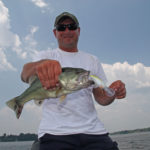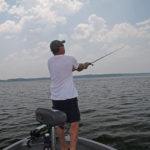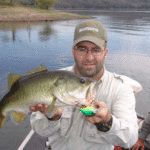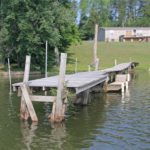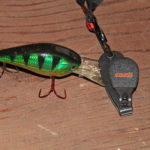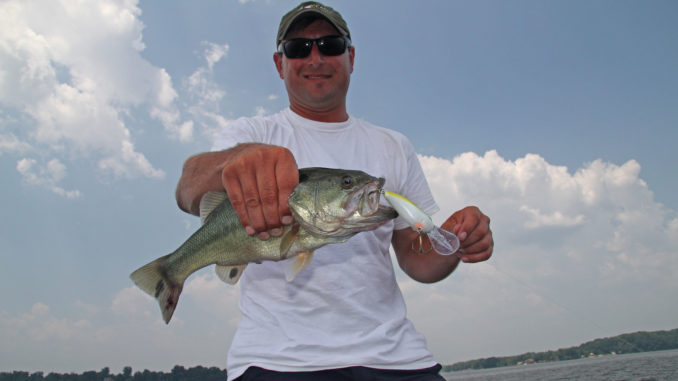
Tune your lures to appeal to the bass base.
This one leans to the left; that one goes far right. Here’s one that keeps a centrist course.
We could be talking about politicians, but that description can also apply to a tray of crankbaits.
Sometimes a straight course fits the need, but other times, anglers may want their baits to run more to one side or the other. Maybe you’re tracing the edge of a channel or paralleling a line of riprap. Sometimes you’ll find that wind, current and/or sunlight are simply making one side of the structures more productive.
I recently quizzed a couple of Bassmaster pros, Takahiro Omori and Gerald Swindle, on their crankbait strategies. Omori finds most modern hard plastic crankbaits are tuned pretty tightly right out of the package. However, with handmade balsa-wood baits, he expects each one to perform differently, so tuning is the assumption.
Swindle tunes his crankbaits to run right or left when fishing bridge columns, floating docks or piers with wooden support legs. With the latter, Swindle notes an inherent hazard of off-center cranking.
“If the bait’s running too hard, it’s not naturally deflecting off the wood, so it’s going to hang more,” he said. “When I tune a bait to run up under a piece of structure, I want it to be open water so it can run under there and know that the chances of it hanging are less.”
Now when it comes to cranking riprap, ticking that bait off the top of the rocks is standard operating procedure for most. That certainly works, but making the crankbait swing in from a lateral approach gives the fish a different look, so try tuning it to one side or the other. That may sound like it locks you into a single direction, but Swindle says “not so.”
“During a tournament, I was cranking one particular stretch of riprap and I knew I was going to be going up and down it for hours on end,” he said. “I took two identical baits on two identical rods and I tuned one bait to run just a little to the left and one to run just a little to the right. I fished the right-handed bait going down the bank and when I got to the end, I swapped rods, turned around and came back. That way I maintained maximum contact with the rocks.”
For deep cranking, Omori demands crankbaits that run perfectly straight to maximize depth. Swindle agrees and if he sees a fellow deep-cranking angler reeling in a bait with a lateral skew, he knows that bait is a) not reaching as deep as the angler thinks its reaching, and b) not remaining in the strike zone long enough for an effective presentation.
A key factor in selecting crankbaits is the wobble — some shimmy tightly; others shake like their tails are on fire. Both have their time to shine, and Swindle keeps it simple with a rule of thumb.
“The colder the water, the tighter the wiggle; the warmer the water, the wider the wiggle,” he said. “In warmer water, the bait fish are moving faster.
“You can do a simple experiment at home to see for yourself. Buy some minnows, put them in a minnow bucket and sit them outside. Let that temperature get down to the upper 40s and then bump that bucket, the minnows won’t swim fast at all — they’ll just barely flex out. They’re not explosive, even when they’re fleeing from something. That’s the type of (crankbait) vibration you’re looking for in cold water.
“But if that minnow bucket was warm and those minnows were all feeling good and energetic, if you bumped that bucket, they’d dart from side to side. That’s a harder vibration, which comes back to a wider-wobbling crankbait.”
How to tune
When adjusting his crankbaits, Omori finds that needle-nosed pliers usually do the trick. Others may opt for tuning tools — those little notches on the sides of pliers or fishing-themed multi-tools. Line clippers have also evolved into multi-taskers, and Swindle helped design a nifty one called the 2HANDEE. In addition to a utility blade under the clipper and a wet stone on the backside, the 2HANDEE features a lure tuner at the base.
Similarly, Berkley and Rapala clippers come with crankbait-tuning notches built into their bodies. Lanyards keep these tools handy around an angler’s neck, attached to a belt loop or hung from a steering wheel.
However you tune your baits, don’t overdo it, lest you ruin the tracking or compromise the structural integrity of the line tie. As Bassmaster Elite pro Gerald Swindle notes: “Most of the time, when tuning a crankbait, less is more.”
Also, smooth and steady pressure works much better than impatient wrenching. For one thing, too much ill-directed force can lead to over-adjustments that mar the bait’s performance. Also, where treble hooks dangle, careful movements and measured force are always the best policy.
Seasoned anglers can feel their baits running correctly or not so, but if you need a visual cue, just tie on a bait, drop it next to the boat and watch how it performs. Omori has a swimming pool at his home and, well, his baits spend a lot more water time than he does.
“I call it the ‘test tank,’” Omori joked. “You have to have crystal-clear water.
“On a lake, you have to have a calm surface with little wind to be able to see (the bait). Most of the time on the lake it’s not that clear, so I do it at home.”
The right outfit
As Omori points out, the type of rod, reel and line you’ll need for cranking depends on how you’re fishing. Variations are many, but depth is the most important element, so he breaks it down with a shallow-versus-deep analysis. Anglers can build upon these principals to fit their specific preferences.
“If you’re throwing a shallow-running crankbait and making a lot of short casts, you don’t want more than a 7-foot rod, because if it’s too long, it’s hard to make accurate casts,” Omori said. “But if I’m fishing deep-diving crankbaits, I want to have like a 7-10 — the longest rod you can get — so I can have more casting distance.”
Omori goes with a low gear-ratio reel for deep-diving cranks so he doesn’t wear himself out winding. Conversely, in the shallow game, his 7.3:1 reel lets him cover water quickly, retrieve at a zippy pace and make the most casts possible. For deep water he likes 10-pound fluorocarbon because it sinks faster than the 20-pound he uses in the obstruction-heavy shallows.
“For shallow-diving crankbaits, I’ll use shorter-handle reels and for deep diving, I’ll have longer-handle reels so I can have more winching power,” Omori adds. “If you (fish crankbaits) all day long, you’ll see that those little things make a big difference.”
